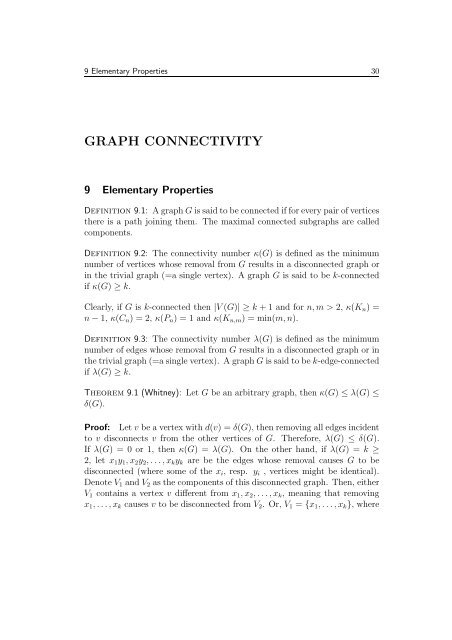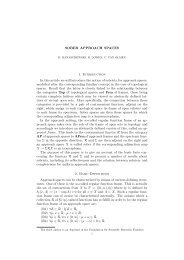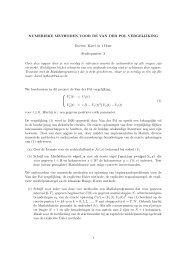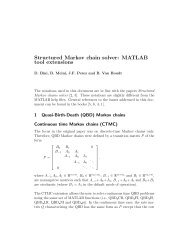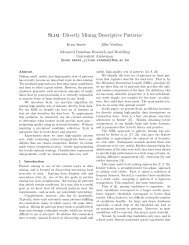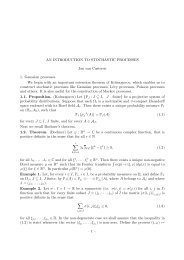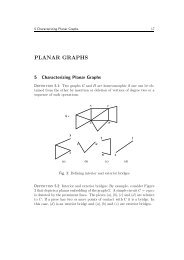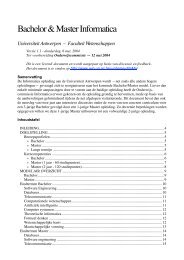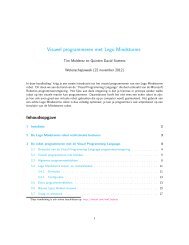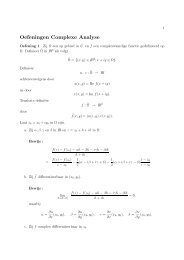GRAPH CONNECTIVITY
GRAPH CONNECTIVITY
GRAPH CONNECTIVITY
You also want an ePaper? Increase the reach of your titles
YUMPU automatically turns print PDFs into web optimized ePapers that Google loves.
9 Elementary Properties 30<strong>GRAPH</strong> <strong>CONNECTIVITY</strong>9 Elementary PropertiesDefinition 9.1: A graph G is said to be connected if for every pair of verticesthere is a path joining them. The maximal connected subgraphs are calledcomponents.Definition 9.2: The connectivity number κ(G) is defined as the minimumnumber of vertices whose removal from G results in a disconnected graph orin the trivial graph (=a single vertex). A graph G is said to be k-connectedif κ(G) ≥ k.Clearly, if G is k-connected then |V (G)| ≥ k + 1 and for n, m > 2, κ(K n ) =n − 1, κ(C n ) = 2, κ(P n ) = 1 and κ(K n,m ) = min(m, n).Definition 9.3: The connectivity number λ(G) is defined as the minimumnumber of edges whose removal from G results in a disconnected graph or inthe trivial graph (=a single vertex). A graph G is said to be k-edge-connectedif λ(G) ≥ k.Theorem 9.1 (Whitney): Let G be an arbitrary graph, then κ(G) ≤ λ(G) ≤δ(G).Proof: Let v be a vertex with d(v) = δ(G), then removing all edges incidentto v disconnects v from the other vertices of G. Therefore, λ(G) ≤ δ(G).If λ(G) = 0 or 1, then κ(G) = λ(G). On the other hand, if λ(G) = k ≥2, let x 1 y 1 , x 2 y 2 , . . .,x k y k are be the edges whose removal causes G to bedisconnected (where some of the x i , resp. y i , vertices might be identical).Denote V 1 and V 2 as the components of this disconnected graph. Then, eitherV 1 contains a vertex v different from x 1 , x 2 , . . .,x k , meaning that removingx 1 , . . ., x k causes v to be disconnected from V 2 . Or, V 1 = {x 1 , . . .,x k }, where
9 Elementary Properties 321. Give 4 graphs G 1 , G 2 , G 3 and G 4 such that 0 < κ(G 1 ) = λ(G 1 ) = δ(G 1 ),0 < κ(G 2 ) < λ(G 2 ) = δ(G 2 ), 0 < κ(G 3 ) = λ(G 3 ) < δ(G 3 ), and0 < κ(G 4 ) < λ(G 4 ) < δ(G 4 ).2. Give a graph G such that κ(G) = 2δ(G) + 2 − n > 0.3. Determine the minimum e(n) such that all graphs with n vertices ande(n) edges are connected (= 1-connected).4. Let G be a graph with n vertices and e edges, show κ(G) ≤ λ(G) ≤⌊2e/n⌋.5. Let G be a graph with δ(G) ≥ ⌊n/2⌋, then G connected. Moreover,λ(G) = δ(G) [Hint: Prove that any component C i of G, after removingλ(G) < δ(G) edges, contains at least δ(G) + 1 vertices.].6. Let G be any 3-regular graph, i.e., δ(G) = ∆(G) = 3, then κ(G) =λ(G). Draw a 4-regular planar graph G such that κ(G) ≠ λ(G).Theorem 9.2: Given the integers n, δ, κ and λ, there is a graph G of ordern such that δ(G) = δ, κ(G) = κ, and λ(G) = λ if and only if one of thefollowing conditions is satisfied:1. 0 ≤ κ ≤ λ ≤ δ < ⌊n/2⌋,2. 1 ≤ 2δ + 2 − n ≤ κ ≤ λ = δ < n − 1,3. κ = λ = δ = n − 1.Of course, if κ(G) = 0, then so is λ(G).Proof: Let G be any graph of order n with δ(G) = δ, κ(G) = κ, andλ(G) = λ. Then, (a) δ(G) < ⌊n/2⌋, that is, condition 1 is true, or (b)⌊n/2⌋ ≤ δ(G) < n −1, meaning that 2δ ≥ 2⌊n/2⌋ ≥ n −1, or 2δ +2−n ≥ 1.Thus, by Corollary 1.2 and Exercise 1.1.5 we have condition 2. Or (c) ifδ(G) = n − 1, then G = K n and κ(G) = λ(G) = δ(G) = n − 1.Thus we have to show that if condition 1, 2 or 3 is satisfied then there is agraph G with appropriate constants n, κ, λ, δ. Suppose that condition 1 holds.Let G 1 = K δ+1 , G 2 = K n−δ−1 , u 1 , . . .,u δ+1 ∈ G 1 and v 1 , . . ., v δ+1 ∈ G 2 (notice,K δ+1 ⊂ G 2 ). Next, set G = G 1 ∪G 2 and add the edges u 1 v 1 , . . .,u κ v κ andu κ+1 v 1 , . . .,u λ v 1 to G. Then, κ(G) = κ, by removing the vertices v 1 , . . .,v κ ,
10 Menger’s Theorem 33λ(G) = λ, by removing the edges between G 1 and G 2 , and δ(G) = δ, byconsidering the vertex u δ+1 . Suppose that condition 2 holds. Let G 1 = K κ ,G 2 = K a , G 3 = K b and G 0 = G 1 + (G 2 ∪ G 3 ), where a = ⌊(n − κ)/2⌋ andb = ⌊(n−1−κ)/2⌋ (notice, a+b = n−κ−1) 7 . To construct G, add a vertexv to G 0 and joint it to the vertices of G 1 and to δ − κ vertices of G 3 (this ispossible because 2δ + 2 − n ≤ κ implies that δ − κ ≤ b). Then, κ(G) = κ,by removing the vertices of G 1 , λ(G) = λ, by removing the edges to v, andδ(G) = δ, by considering the vertex v. Finally, if condition 3, holds, setG = K n .Q.E.D.10 Menger’s TheoremDefinition 10.1: The local connectivity κ(x, y) of two non-adjacent verticesis the minimum number of vertices separating x from y. If x and y areadjacent vertices, their local connectivity is defined as κ H (x, y) + 1 whereH = G − xy. Similarly, we define the local edge-connectivity λ(x, y).Clearly, κ(G) = min{κ(x, y)|x, y ∈ G, x ≠ y}. The aim of this section is todiscuss the fundamental connections between κ(x, y) and the set of xy paths.Two paths in a graph G are said to be independent if every common vertexis an endvertex of both paths. A set of independent xy paths is a set of pathsany two of which are independent. Obviously, if there are k independent xypaths then κ(x, y) ≥ k. Menger’s Theorem states that the converse is true.We prove the theorem by means of an elegant proof by Dirac (1969).Theorem 10.1 (Menger (1926)): Let x, y ∈ G, x ≠ y. There exists a set ofκ(x, y) independent paths between x and y and this set is maximal.Proof: We use induction on m = n + e, the sum of the number of verticesand edges in G. We show that if S = {w 1 , w 2 , . . ., w k } is a minimum set(that is, a subset of the smallest size) that separates x and y, then G has atleast k independent paths between x and y. The case for k = 1 is clear, andthis takes care of the small values of m, required for the induction.(1) Assume that x and y have a common neighbor z ∈ Γ(x) ∩ Γ(y). Thennecessarily z ∈ S. In the smaller graph G − z the set S − z is a minimum7 G+H is used here to reflect the graph obtained by G∪H and adding an edge betweenevery vertex x ∈ G and y ∈ H
10 Menger’s Theorem 34set that separates x and y, and so the induction hypothesis yields that thereare k − 1 independent paths between x and y in G − z. Together with thepath xzy, there are k independent paths in G as required.(2) Assume that Γ(x) ∩Γ(y) = ∅ and denote by H x and H y as the connectedcomponents of G − S for x and y, respectively.(2a) Suppose that the separating set S ⊄ Γ(x) and S ⊄ Γ(y). Let z be anew vertex, and define G z to be the graph with the vertices V (H x ∪ S ∪ z)having the edges of G[H x ∪S] together with the edges zw i for all i = 1, . . .,k.The graph G z is connected and it is smaller than G. Indeed, in order for Sto be a minimum separating set, all w i vertices have to be adjacent to somevertex in H y . This shows that e(G z ) ≤ e(G) and, moreover, assumption (2a)rules out the case H y = y, therefore n(G z ) < n(G) in the present case. IfT is any set that separates x and z in G z , then T will separate x from allw i ∈ S −(T ∩S) in G. This means that T separates x and y in G. Since k isthe size of a minimum separating set, |T | = k. We noted that G z is smallerthan G, and thus by the induction hypothesis, there are k independent pathsfrom x to z in G z . This is possible only if there exist k independent pathsfrom x to w i , for i = 1, . . ., k, in H x . Using a symmetric argument one findsk independent paths from y to w i in H y . Combining these paths proves thetheorem.(2b) Suppose that all separating sets S are a subset of Γ(x) or Γ(y). Let Pbe the shortest path from x to y in G, then P contains at least 4 vertices,we refer to the second and third node as u and v. Define G n as G −uv (thatis, remove the edge between u and v). If the smallest set T that separatesx from y in G n has a size k, then by induction, we are done. Suppose that|T | < k, then x and y are still connected in G − T and every path from xto y in G − T necessarily travels along the edge uv. Therefore, u, v ∉ T.Also, T u = T ∪ u and T v = T ∪ v are both minimum separating sets in G(of size k). Thus, T v ⊂ Γ(x) or T v ⊂ Γ(y) (by (2b)). Now, P is the shortestpath, so v ∉ Γ(x), hence, T v ⊂ Γ(y). Moreover, u ∈ Γ(x), thus T u ⊂ Γ(x).Combining these two results we find T ⊂ Γ(x) ∩ Γ(y) (and T is not empty).Which contradicts assumption (2).The set is maximal, because the existence of k independent paths between xand y implies that κ(x, y) ≥ k.Q.E.D.Another way to state this result is the following: A necessary and sufficientcondition for a graph to be k-connected is that any two distinct vertices xand y can be joined by k independent paths.
11 Additional Exercises 35Exercises 10.1: On Menger’s Theorem:• Let G be a graph with |G| ≥ k +1, then G is k-connected if and only iffor all k-element subsets V 1 , V 2 ∈ V (G), there is a set of k paths fromV 1 to V 2 which have no vertex in common. [V 1 ∩ V 2 is not necessarilyempty, thus, some paths might be trivial paths].Let U be a set of vertices of a graph G and let x be a vertex not in U. AnxU fan is defined as a set of |U| paths from x to U, any two of which haveonly the vertex x in common.Theorem 10.2 (Dirac (1960)): A graph G is k-connected if and only if |G| ≥k + 1 and for any k-set U ∈ V (G) and x ∈ V (G) − U, there is an xU fan.Proof: (a) Suppose that G is k-connected, U ⊂ V (G), |U| = k and x ∈V (G) − U. Let H be the graph obtained from G by adding a vertex y andjoining y to every vertex in U. Clearly, H is also k-connected. Therefore,by Menger’s theorem, we find that there are k independent xy paths in H.Omitting the edges incident with y, we find the required xU fan.(b) Suppose |G| ≥ k + 1 and that S is a (k − 1)-set separating x and y, forsome vertices x and y. Then, G does not contain an x(S ∪ y) fan.Q.E.D.Exercises 10.2: On Dirac’s Theorem:1. If G is k-connected (k ≥ 2), then for any set of k vertices {a 1 , . . .,a k }there is a cycle containing all of them. [Hint: Use induction on k anddistinguish between the case where the cycle C contains an additionalvertex x ∉ {a 1 , . . ., a k−1 } and the case where it does not.]2. Give an example of a graph for which there is for any set of k points,a cycle containing all of them, but that is not k-connected (k > 2).11 Additional ExercisesDefinition 11.1: Let k ≥ 1. Consider the set B k of all binary sequences oflength k. For instance, B 3 = {000; 001; 010; 100; 011; 101; 110; 111}. Let Q kbe the graph (called the k-cube) with V (Q k ) = B k , where uv ∈ E(Q k ) if andonly if the sequences u and v differ in exactly one place.
11 Additional Exercises 36Exercises 11.1: On k-cube graphs Q k :• Determine the order of Q k . Show that Q k is regular, and determinee(Q k ) for each k ≥ 1.• Compute χ(Q k ) for all k ≥ 1.• Prove that κ(Q k ) = λ(Q k ) = δ(Q k ) = k [Hint: use induction on k.Consider the graphs G 0 and G 1 induced by the vertices 0u and 1u,respectively. Let S be a minimal set that disconnects Q k , then S mustdisconnect G 0 or G 1 ].• Determine the k values for which Q k is planar.


